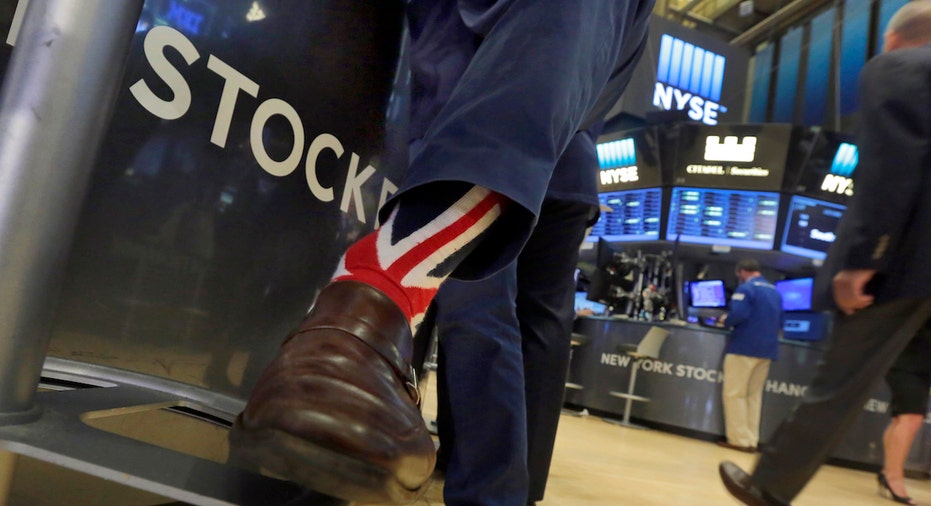Brexit Bargain Hunters Help Boost Financials in Broad Wall Street Rally

Equity markets around the world halted their Brexit-induced selloff on Tuesday as bargain hunters looked to snap up high-quality names at discount prices. Leading the rally in the U.S. were cyclical sectors including energy, technology, consumer discretionary, and financials.
The beaten-down financials sector jumped 2.47% after it saw the biggest two-day drop since 2011 and suffered the steepest losses of all 10 S&P 500 sectors in the two trading days following the United Kingdom’s decision to exit the European Union.
Names in financials-sector space including Travelers (NYSE:TRV), JPMorgan Chase (NYSE:JPM), and Goldman Sachs (NYSE:GS), helped lead the Dow Jones Industrial Average up more than 260 points, or 1.5% on the session, while the S&P 500 gained 1.78%, and the Nasdaq jumped 2.12%.
With pessimism seemingly waning in global financial markets, investors might be tempted by the opportunity to reposition their portfolios. Dick Bove, equity analyst at Rafferty Capital Markets advised taking the discounts and running with them.
“If you’ve got a dart and a list of banks, throw the dart and buy whatever it hits,” he said.
Bove’s rationale for unabashedly investing in U.S. bank stocks is due to their fundamentally-sound nature that’s been bolstered in the wake of the financial crisis. Incidentally, last Thursday ahead of the UK’s Brexit decision, the Federal Reserve said all 33 of the biggest U.S. banks passed their stress tests, showing they were capitalized sufficiently enough to continue making loans in the event of an economic depression.
Given that, Bove said he couldn’t understand why Wall Street was punishing the financial sector so much, other than due to indiscriminate selling in panicked trading. The five-biggest U.S. banks, which include JPMorgan, Goldman Sachs, Morgan Stanley (NYSE:MS), Bank of America (NYSE:BAC), Wells Fargo (NYSE:WFC), and Citigroup (NYSE:C), have seen their share prices drop significantly in the wake of the Brexit decision with Morgan Stanley falling 38% from its 52-week high.
"If you’ve got a dart and a list of banks, throw the dart and buy whatever it hits."
“What the market is telling you is they don’t have a clue how banks function,” Bove said. “You’ve built a banking industry in this country which has more stability, more liquidity, more capital than you’ve seen in roughly 45 years, and at the same time that’s happened, people are worried there’s some counterparty risk coming out of Europe, which [they worry is] basically is going to impact the stability of the American banks.”
While worries over American economic stability and lower-for-longer interest rates at the hands of the Fed have certainly been a concern among those who have pulled money from bank stocks, Brexit tacked on yet another prong of uncertainty for the sector. For the more than 40-years the U.K. has been a member of the EU, global banks have used physical locations in London as a way to “passport,” or do business with other EU nations. With the U.K. looking to unwind itself from the trading bloc, investors aren’t quite certain how the move will impact the banking sector, though some bank executives have warned it could lead to job cuts or an all-out relocation of their European headquarters.
Tom Naratil, UBS Americans president and CEO, said it’s too early to tell what the implications will be.
“That’ll take some time as the negotiation on how the U.K. exits is completed,” he said. “But the secondary effects, that’s what you’re really seeing coming through in stocks, are prospects of further central banks either easing or not tightening as quickly as people have priced in. That compresses net interest margin, and as a result, defers some of the dividend rebounds some people have been expecting in the banking sector.”
Indeed, the European Central Bank and the Bank of Japan have already lowered interest rates into negative territory, and Goldman Sachs economists have forecast the Bank of England to react to the Brexit shock with a 0.25% cut in interest rates, with more easing on the way from the ECB and the BOJ.
Meanwhile, uncertainty abounds for the Fed and its path to hiking rates in such an uncertain environment. Wall Street’s expectation as measured by fed funds futures show just a 9% chance of at least one interest-rate increase in the U.S. by the central bank’s December meeting.
Still, Naratil said UBS advisors have been communicating to clients who have cash ready to deploy in the market they should take advantage of the pullback and invest in the U.S. equity market. He cited GDP that “is in good shape,” and a Fed, though accommodative, likely to move “at some point.”
“If you look at the first quarter of 2016, we feel like profits troughed and we’re likely to see profits go higher,” he said. “It’s certainly going to be challenging for those in Europe, but at the same time, we think Asia and the U.S. will pull the rest of the world forward.”



















